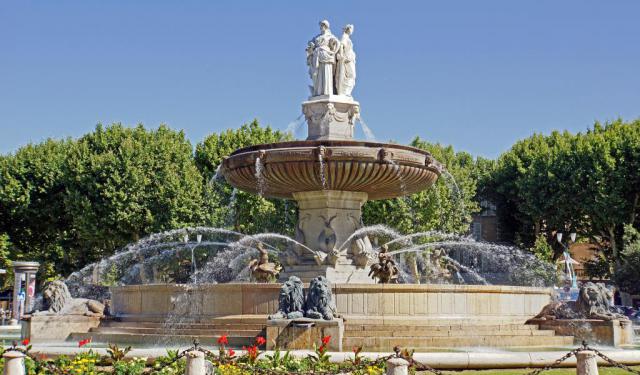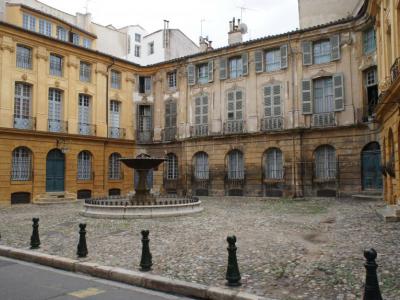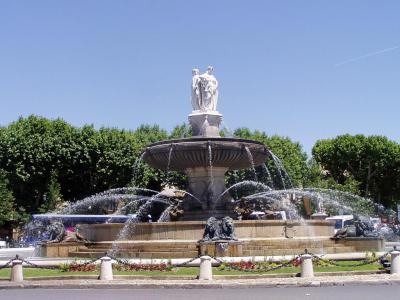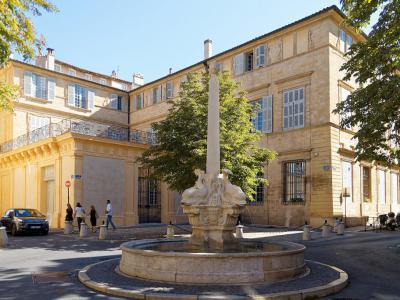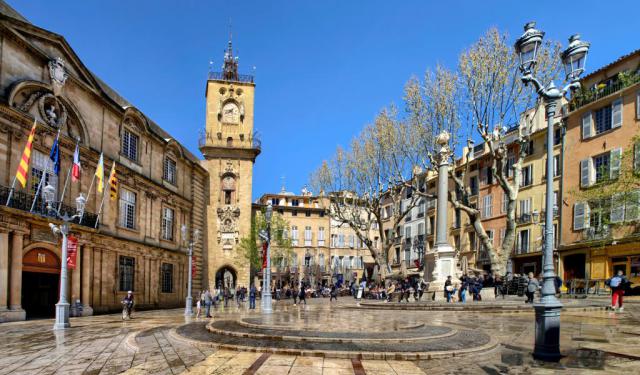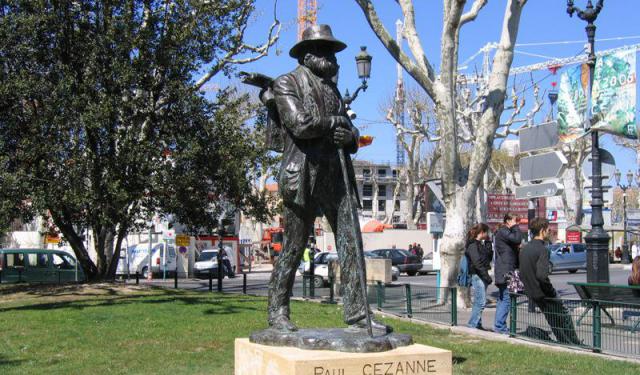Aix-en-Provence Fountains and Squares Tour (Self Guided), Aix-en-Provence
Aix-end-Provence is known for its fountains. With more than 1,000 fountains, a tourist could spend weeks walking around the city without glimpsing them all. The fountains began appearing under the Roman empire when the Romans discovered Aix's natural thermal water source. They referred to the area as Aquae Sextiae or the Waters of Sextius.
The fountains appear throughout the city and are prominent features in many of the squares. There are unique fountains like the Boar Fountain found at Richelme Square and more traditional fountains, like the one seen at Place des Trois Ormeaux. The larger-than-life obelisk at Place des Precheurs has fountains at its base, while Place et Fontaine d'Albertas is as known for the large, central fountain as it is for the square itself.
Other fountains popular among visitors are the Fontaine des Augustins (Fountain of the Augustins), Fontaine de la Rotonde (Fountain of the Rotunda), Fontaine des Neuf-Canons (Fountain of the Nine Cannons), Fontaine du Roi Rene (King Rene Fountain) and Fontaine Moussue (Mossy Fountain).
Arguably one of the most famous fountains in the city is Fontaine des Quatre Dauphins. This fountain was the first free-standing fountain in Aix-en-Provence. It was built by Jean-Claude Rambot in 1667.
Take this self-guided walking tour to see the beautiful fountains and squares of Aix-en-Provence.
The fountains appear throughout the city and are prominent features in many of the squares. There are unique fountains like the Boar Fountain found at Richelme Square and more traditional fountains, like the one seen at Place des Trois Ormeaux. The larger-than-life obelisk at Place des Precheurs has fountains at its base, while Place et Fontaine d'Albertas is as known for the large, central fountain as it is for the square itself.
Other fountains popular among visitors are the Fontaine des Augustins (Fountain of the Augustins), Fontaine de la Rotonde (Fountain of the Rotunda), Fontaine des Neuf-Canons (Fountain of the Nine Cannons), Fontaine du Roi Rene (King Rene Fountain) and Fontaine Moussue (Mossy Fountain).
Arguably one of the most famous fountains in the city is Fontaine des Quatre Dauphins. This fountain was the first free-standing fountain in Aix-en-Provence. It was built by Jean-Claude Rambot in 1667.
Take this self-guided walking tour to see the beautiful fountains and squares of Aix-en-Provence.
How it works: Download the app "GPSmyCity: Walks in 1K+ Cities" from Apple App Store or Google Play Store to your mobile phone or tablet. The app turns your mobile device into a personal tour guide and its built-in GPS navigation functions guide you from one tour stop to next. The app works offline, so no data plan is needed when traveling abroad.
Aix-en-Provence Fountains and Squares Tour Map
Guide Name: Aix-en-Provence Fountains and Squares Tour
Guide Location: France » Aix-en-Provence (See other walking tours in Aix-en-Provence)
Guide Type: Self-guided Walking Tour (Sightseeing)
# of Attractions: 10
Tour Duration: 1 Hour(s)
Travel Distance: 1.6 Km or 1 Miles
Author: DanaOffice
Sight(s) Featured in This Guide:
Guide Location: France » Aix-en-Provence (See other walking tours in Aix-en-Provence)
Guide Type: Self-guided Walking Tour (Sightseeing)
# of Attractions: 10
Tour Duration: 1 Hour(s)
Travel Distance: 1.6 Km or 1 Miles
Author: DanaOffice
Sight(s) Featured in This Guide:
- Richelme Square and the Boar Fountain
- Place des Trois Ormeaux (Three Elms Square)
- Place des Prêcheurs (Preachers Square)
- Place et Fontaine d'Albertas (Albertas Square and Fountain)
- Fontaine des Augustins (Fountain of the Augustins)
- Fontaine de la Rotonde (Fountain of the Rotunda)
- Fontaine des Neuf-Canons (Fountain of the Nine Cannons)
- Fontaine Moussue (Mossy Fountain)
- Fontaine du Roi René (King Rene Fountain)
- Mazarin District and Fountain of the Four Dolphins
1) Richelme Square and the Boar Fountain
Richelme Square (Place Richelme) is widely known as the oldest and one of the most beautiful squares in Aix-en-Provence. The centrally-located square is surrounded by buildings with gilded facades and looming trees that cast comforting shadows.
During the daytime, Richelme Square hosts a food market that has been around since the 14th century. While the square is popular with tourists, most shoppers are locals. Visitors can enjoy shopping alongside residents before sitting at one of the tables to enjoy a picnic lunch.
The daily food market closes every evening. Richelme Square then becomes a spot for dining or having drinks. It is not a party atmosphere but an elegant place to relax.
The Boar Fountain (Fontana del Porcellino di Aix) is a primary feature of Richelme Square. The giant bronze boar is fashioned after a 17th-century statue in Florence, Il Porcellino (Italian "piglet"). The Boar was first displayed at the Town Hall, then moved to Richelme Square in the 1980s. It is situated outside the upmarket food chain, The Daily Bread (Le Pain Quotidien). The Boar Fountain is a great place to meet friends after browsing the market.
During the daytime, Richelme Square hosts a food market that has been around since the 14th century. While the square is popular with tourists, most shoppers are locals. Visitors can enjoy shopping alongside residents before sitting at one of the tables to enjoy a picnic lunch.
The daily food market closes every evening. Richelme Square then becomes a spot for dining or having drinks. It is not a party atmosphere but an elegant place to relax.
The Boar Fountain (Fontana del Porcellino di Aix) is a primary feature of Richelme Square. The giant bronze boar is fashioned after a 17th-century statue in Florence, Il Porcellino (Italian "piglet"). The Boar was first displayed at the Town Hall, then moved to Richelme Square in the 1980s. It is situated outside the upmarket food chain, The Daily Bread (Le Pain Quotidien). The Boar Fountain is a great place to meet friends after browsing the market.
2) Place des Trois Ormeaux (Three Elms Square)
The Three Elms Square (Place des Trois Ormeaux) is a small town square near the center of Aix-en-Provence. It was named after its fountain, the Three Elms Fountain, which, in turn, was named for three elms planted in a triangle at each corner of the plaza.
There is a legend that the elms magically grew in an area where local soldiers took up arms against the ruler of Aix. Though the square remains named The Square of the Three Elms, the elm trees were removed and replaced with plane trees. Three Elms Square was previously named for the Consul of Aix-en-Provence, Bertrand Berici, who lived here at the beginning of the 15th century.
The fountain, made from Calissane and Bibemus stone, stands in the center of the square. The 17th-century fountain has a polygonal base with a central pedestal from which the water flows out of six cannons. The pedestal is carved with a floral motif, and vine leaves with a sublime bunch of grapes at the top. The fountain has stood the test of time with modesty and simple beauty.
The Three Elms Square is surrounded by houses, shops, and restaurants. Tourists should pay close attention to the door of the Saphallin Hotel, which dates to 1672.
There is a legend that the elms magically grew in an area where local soldiers took up arms against the ruler of Aix. Though the square remains named The Square of the Three Elms, the elm trees were removed and replaced with plane trees. Three Elms Square was previously named for the Consul of Aix-en-Provence, Bertrand Berici, who lived here at the beginning of the 15th century.
The fountain, made from Calissane and Bibemus stone, stands in the center of the square. The 17th-century fountain has a polygonal base with a central pedestal from which the water flows out of six cannons. The pedestal is carved with a floral motif, and vine leaves with a sublime bunch of grapes at the top. The fountain has stood the test of time with modesty and simple beauty.
The Three Elms Square is surrounded by houses, shops, and restaurants. Tourists should pay close attention to the door of the Saphallin Hotel, which dates to 1672.
3) Place des Prêcheurs (Preachers Square)
Preachers Square (Place des Prêcheurs) is a public plaza with a stunning fountain. It was named after the Dominican convent near the square, destroyed during the French Revolution.
The square was first designed in the 15th century by artist Jean de Paris. It was expanded and beautified around 1640 by architect Jean Lombard. The Preachers Square, now admired for its beauty, was once used for pu vbblic shaming and executions.
The Prêcheurs fountain, added in 1748, was crafted by sculptor Jean-Pancrace Chastel. It consisted of a tall obelisk with four lions guarding each corner. The four medallions embedded in the obelisk feature Sextus, the founder of the Roman city, Charles III, Louis XV, and Louis XVIII.
The fountain was destroyed in 1793. The restoration of the Prêcheurs fountain didn't take place until 1833.
Preachers Square is located in front of the Madeleine Church, constructed between 1691 and 1703. The church is known for its many works of art by artists who lived in Aix. It was the home church of artist Paul Cezanne and his family.
The square was first designed in the 15th century by artist Jean de Paris. It was expanded and beautified around 1640 by architect Jean Lombard. The Preachers Square, now admired for its beauty, was once used for pu vbblic shaming and executions.
The Prêcheurs fountain, added in 1748, was crafted by sculptor Jean-Pancrace Chastel. It consisted of a tall obelisk with four lions guarding each corner. The four medallions embedded in the obelisk feature Sextus, the founder of the Roman city, Charles III, Louis XV, and Louis XVIII.
The fountain was destroyed in 1793. The restoration of the Prêcheurs fountain didn't take place until 1833.
Preachers Square is located in front of the Madeleine Church, constructed between 1691 and 1703. The church is known for its many works of art by artists who lived in Aix. It was the home church of artist Paul Cezanne and his family.
4) Place et Fontaine d'Albertas (Albertas Square and Fountain)
Back in the 16th century, Jean Agar-an adviser to the Parliament of Aix-decided to part ways with his residence, handing it off. A few generations later, the house's square got sold to the d'Albertas clan, who had traded the hills of Alba, Italy, for Provence way back in the 14th century. Skipping forward to 1724, and Henri d'Albertas, royal adviser and apparent fan of urban upgrades, hired city architect Laurent Vallon to give his home a stylish overhaul. Not content with curb appeal alone, Henri bought the houses across the street and promptly flattened them for the greater architectural good.
Henri didn’t live to see the full glow-up, but his son Jean-Baptiste picked up where Dad left off, handing the project to Laurent’s son, Georges Vallon. Now that is a generational collaboration, literally. Georges, now city architect himself, drew inspiration from the grand squares of Paris and created a petite but polished plaza in front of the family residence. Today’s Albertas Square is framed by four nearly identical mansions, all with dignified facades and balconies that seem to ask, “Did someone order symmetry?”
At its center stands the Albertas Fountain-a cast-iron chalice calmly anchoring the square with just enough presence to turn heads without raising eyebrows. The decorative railing encircling the basin was forged by students from the local School of Arts and Crafts, their style merging seamlessly to the architect's.
Henri didn’t live to see the full glow-up, but his son Jean-Baptiste picked up where Dad left off, handing the project to Laurent’s son, Georges Vallon. Now that is a generational collaboration, literally. Georges, now city architect himself, drew inspiration from the grand squares of Paris and created a petite but polished plaza in front of the family residence. Today’s Albertas Square is framed by four nearly identical mansions, all with dignified facades and balconies that seem to ask, “Did someone order symmetry?”
At its center stands the Albertas Fountain-a cast-iron chalice calmly anchoring the square with just enough presence to turn heads without raising eyebrows. The decorative railing encircling the basin was forged by students from the local School of Arts and Crafts, their style merging seamlessly to the architect's.
5) Fontaine des Augustins (Fountain of the Augustins)
The Fountain of the Augustins (Fontaine des Augustins) is situated in Augustine Square, in the center of Aix-en-Provence. The old center of Aix attracts with its narrow streets, lovely shops, fountains, statues, and colorful facades. The mini square, where the fountain stays, is surrounded by restaurants and cafes with plenty of outdoor seating.
The fountain was built twice. The first fountain was built in 1620 near Espariat Street, about 95 meters from its current location. The second iteration came in 1820 when the old fountain was dismantled and a new one, designed by Aix architect Beisson, was built. In the days gone by, the water from the basin was used for steam locomotives in the nearby train station.
The central element of the fountain, a Roman column originating from the demolished Palace of the Counts of Provence, was added later. The palace was located in the spot where the courthouse now stands. A 12-sided copper star sits atop the column. At its base, four cannons spill into a large, circular basin.
The fountain was listed as a historic monument in 1949. It is one of only four fountains in Aix-en-Provence that uses a natural spring as its water source.
The fountain was built twice. The first fountain was built in 1620 near Espariat Street, about 95 meters from its current location. The second iteration came in 1820 when the old fountain was dismantled and a new one, designed by Aix architect Beisson, was built. In the days gone by, the water from the basin was used for steam locomotives in the nearby train station.
The central element of the fountain, a Roman column originating from the demolished Palace of the Counts of Provence, was added later. The palace was located in the spot where the courthouse now stands. A 12-sided copper star sits atop the column. At its base, four cannons spill into a large, circular basin.
The fountain was listed as a historic monument in 1949. It is one of only four fountains in Aix-en-Provence that uses a natural spring as its water source.
6) Fontaine de la Rotonde (Fountain of the Rotunda)
The Count of Valbelle checked out in 1779, but not before leaving the city of Aix a generous parting gift: 30,000 livres, which was the currency at the time. By November, the city decided to put that money to work-out went the crumbling ramparts, and in came plans for something more civic-minded. Ideas floated around for a while (as they tend to do), but it wasn’t until 1860 that the most iconic splash zone in town got born: the Fountain of the Rotunda.
Long known for its love affair with water-from Roman baths to bubbling neighborhood spouts-Aix needed a proper fountain to fortify its reputation. The Rotunda Fountain delivered. Towering nearly 40 feet, it was the first in the city to feature a cast-iron basin. Lions lounge around its edge like they own the place, while bronze children cling to swans mid-ride, adding just the right touch of misdemeanor.
Further up, a second bowl rests above the pool, this one guarded by snarling cheetah heads that look like they’ve seen things. Crowning the whole affair is a trio of ladies-each facing a different destiny. “Justice,” by Joseph Marius Ramus, stares down Mirabeau Boulevard toward the courthouse. “Commerce and Agriculture,” by Louis Chabaud, keep watch toward Marseille’s factories. And “Fine Arts,” by Hippolyte Ferrat, gazes toward Avignon. Together, they’re known as the Three Graces-a rather dignified nickname for a fountain that never stops showing off.
Long known for its love affair with water-from Roman baths to bubbling neighborhood spouts-Aix needed a proper fountain to fortify its reputation. The Rotunda Fountain delivered. Towering nearly 40 feet, it was the first in the city to feature a cast-iron basin. Lions lounge around its edge like they own the place, while bronze children cling to swans mid-ride, adding just the right touch of misdemeanor.
Further up, a second bowl rests above the pool, this one guarded by snarling cheetah heads that look like they’ve seen things. Crowning the whole affair is a trio of ladies-each facing a different destiny. “Justice,” by Joseph Marius Ramus, stares down Mirabeau Boulevard toward the courthouse. “Commerce and Agriculture,” by Louis Chabaud, keep watch toward Marseille’s factories. And “Fine Arts,” by Hippolyte Ferrat, gazes toward Avignon. Together, they’re known as the Three Graces-a rather dignified nickname for a fountain that never stops showing off.
7) Fontaine des Neuf-Canons (Fountain of the Nine Cannons)
The Fountain of the Nine Cannons (Fontaine des Neuf-Canons) is a fountain and historical monument located on Mirabeau Boulevard, at the intersection of Nazareth Street and Joseph Cabassol Street in Aix-en-Provence.
The fountain, designed by architect Laurent Vallon and constructed in 1691, was named for the nine cannons that shoot water into the basin.
The Fountain of the Nine Cannons was built to provide water to sheep as they passed through the area. At that time, an easement authorized herds of sheep on transhumance between the commune La Crau and the Alps to come and drink there. The lower coping of the basin, as well as the length of its perimeter, was designed in the 17th century.
The fountain was partially destroyed in 1944 during the liberation of Aix-en-Provence. An American tank has taken away one of the four lobes of the basin, this arm was not rebuilt, and its opposite lobe was, on the occasion of this incident, suppressed.
The Fountain of the Nine Cannons was listed as a historical monument in 1929.
The fountain, designed by architect Laurent Vallon and constructed in 1691, was named for the nine cannons that shoot water into the basin.
The Fountain of the Nine Cannons was built to provide water to sheep as they passed through the area. At that time, an easement authorized herds of sheep on transhumance between the commune La Crau and the Alps to come and drink there. The lower coping of the basin, as well as the length of its perimeter, was designed in the 17th century.
The fountain was partially destroyed in 1944 during the liberation of Aix-en-Provence. An American tank has taken away one of the four lobes of the basin, this arm was not rebuilt, and its opposite lobe was, on the occasion of this incident, suppressed.
The Fountain of the Nine Cannons was listed as a historical monument in 1929.
8) Fontaine Moussue (Mossy Fountain)
Mossy Fountain (Fontaine Moussue) is a classic fountain designed by the architect Jean-Claude Rambot. It is known locally as the Mossy Fountain, the Big Green Sponge, or the Hot Water Fountain.
The thermal fountain was built in 1667. It was the first fountain built on the landmark Mirabeau Boulevard. It underwent a major reconstruction in 1687 and 1734.
The moss that grows on the fountain is due to the heated water. As the Mossy Fountain is the only fountain fed from the Thermal Baths, its temperature remains 64 degrees throughout the year.
The fountain's water is not drinkable, still, it can be used for other purposes. Through the beginning of the 20th century, locals used heated water to wash clothing. Water was also regularly taken from the fountain in buckets for washing walkways and steps. Some used the water from the Mossy Fountain to feed their plants.
The Mossy Fountain has suffered from calcification, which makes the design difficult to see. It is believed that the shapes under the limestone deposits are four children holding a basin for the water.
The thermal fountain was built in 1667. It was the first fountain built on the landmark Mirabeau Boulevard. It underwent a major reconstruction in 1687 and 1734.
The moss that grows on the fountain is due to the heated water. As the Mossy Fountain is the only fountain fed from the Thermal Baths, its temperature remains 64 degrees throughout the year.
The fountain's water is not drinkable, still, it can be used for other purposes. Through the beginning of the 20th century, locals used heated water to wash clothing. Water was also regularly taken from the fountain in buckets for washing walkways and steps. Some used the water from the Mossy Fountain to feed their plants.
The Mossy Fountain has suffered from calcification, which makes the design difficult to see. It is believed that the shapes under the limestone deposits are four children holding a basin for the water.
9) Fontaine du Roi René (King Rene Fountain)
King Rene Fountain (Fontaine du Roi René) is one of the fountains on the landmark Mirabeau Boulevard. It was designed by architect Pierre-Henri Revoil in 1819.
King Rene Fountain was built on top of a pyramid-shaped fountain, destroyed during the French Revolution. It now has a circular basin. On this basin is a pedestal with representations of Jean Matheron de Salignac and Palamede de Forbin, companions of King Rene.
The top of the fountain shows a statue crafted by sculptor David d'Angers. It shows René, the Duke of Anjou, the Count of Provence. The likeness shows him holding a scepter and Muscat grapes, which the count had brought to Provence. The statue was placed atop the fountain in 1822.
King Rene Fountain is listed as a historical monument. It was restored in 2009 to commemorate the 600th birthday of King Rene.
King Rene Fountain was built on top of a pyramid-shaped fountain, destroyed during the French Revolution. It now has a circular basin. On this basin is a pedestal with representations of Jean Matheron de Salignac and Palamede de Forbin, companions of King Rene.
The top of the fountain shows a statue crafted by sculptor David d'Angers. It shows René, the Duke of Anjou, the Count of Provence. The likeness shows him holding a scepter and Muscat grapes, which the count had brought to Provence. The statue was placed atop the fountain in 1822.
King Rene Fountain is listed as a historical monument. It was restored in 2009 to commemorate the 600th birthday of King Rene.
10) Mazarin District and Fountain of the Four Dolphins
Right in the heart of Aix’s Mazarin district, you’ll stumble upon the Square of the Four Dolphins-a quiet intersection dressed in 17th-century elegance. It’s flanked by grand mansions, including the Boisgelin Hotel, dreamed up by Pierre Pavillon in 1655. But the real centerpiece is, naturally, the fountain-a quartet of dolphins doing synchronized spray work since the 17th century.
This whole corner of Aix exists thanks to Michel Mazarin, the city’s archbishop with a flair for demolition. Back in 1645, he got the green light from Louis XIV to knock down Aix’s southern ramparts and replace them with something far more fashionable. Inspired by Italian Renaissance planning (and perhaps a few ego trips), architect Jean Lombard laid out a crisp grid of streets and dropped in a proper square right in the middle.
Originally dubbed Saint-Michel Square, the space eventually took its cue from the sculpture at its core. The fountain stars four dolphins coiling around a pedestal, still making a splash. A pine cone is adorned at the top-unexpected, but somehow it works. The dolphins spit water into a wide basin, watched over by four chestnut trees that offer shade with a sense of seniority. It’s a stylish pause in a neighborhood built to impress-and it still does.
This whole corner of Aix exists thanks to Michel Mazarin, the city’s archbishop with a flair for demolition. Back in 1645, he got the green light from Louis XIV to knock down Aix’s southern ramparts and replace them with something far more fashionable. Inspired by Italian Renaissance planning (and perhaps a few ego trips), architect Jean Lombard laid out a crisp grid of streets and dropped in a proper square right in the middle.
Originally dubbed Saint-Michel Square, the space eventually took its cue from the sculpture at its core. The fountain stars four dolphins coiling around a pedestal, still making a splash. A pine cone is adorned at the top-unexpected, but somehow it works. The dolphins spit water into a wide basin, watched over by four chestnut trees that offer shade with a sense of seniority. It’s a stylish pause in a neighborhood built to impress-and it still does.
Walking Tours in Aix-en-Provence, France
Create Your Own Walk in Aix-en-Provence
Creating your own self-guided walk in Aix-en-Provence is easy and fun. Choose the city attractions that you want to see and a walk route map will be created just for you. You can even set your hotel as the start point of the walk.
Aix-en-Provence Introduction Walking Tour
Aix-en-Provence may not have coastal views, but it compensates in style with its Roman bathwater and city logistics. Founded in 123 BC by Roman consul Gaius Sextius Calvinus, this southern French settlement-originally named Aquae Sextiae, which means “Waters of Sextius”-was built around its thermal springs and the promise of a good soak. Centuries later, the name was streamlined to “Aix”,... view more
Tour Duration: 1 Hour(s)
Travel Distance: 1.7 Km or 1.1 Miles
Tour Duration: 1 Hour(s)
Travel Distance: 1.7 Km or 1.1 Miles
In the Footsteps of Paul Cézanne
Paul Cézanne, often called the “father of modern art” for bridging 19th-century post-impressionism and the birth of early modernism, caused a bit of a stir early in his career. While staying with Doctor Gachet in Auvers-sur-Oise, he painted his take on Manet’s Olympia-but with a twist. Instead of just a reclining nude, Cézanne inserted himself into the scene, back turned, like a shy... view more
Tour Duration: 2 Hour(s)
Travel Distance: 3.0 Km or 1.9 Miles
Tour Duration: 2 Hour(s)
Travel Distance: 3.0 Km or 1.9 Miles
The Most Popular Cities
/ view all
